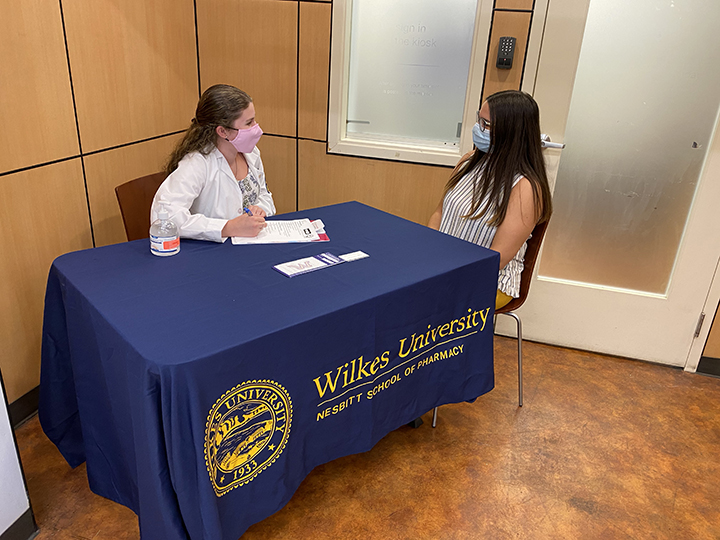As a global pandemic has made telehealth more important in handling routine medical issues, a group of students in Wilkes University’s Nesbitt School of Pharmacy are leveraging technology to pilot a virtual patient education program. Under the mentorship of Nicole Pezzino, assistant professor of pharmacy practice and director of community outreach and innovation for the Nesbitt School, and Danielle Kieck, assistant professor of pharmacy practice, the students are delivering a hypertension education program remotely.
Conducted in cooperation with the two faculty members’ community practice sites at Weis Pharmacy in Schnecksville, Pa., and Cook’s Pharmacy in Kingston, Pa., the eight-week program is delivered using the Zoom online platform. Each student counsels five patients once a week for about 20 minutes. Participating students are second-year pharmacy students Jaycee Blair and Emily Yenser, third-year pharmacy students Maryann Chapin and Stephanie Ostir, and post-graduate community pharmacy resident Sydney Lovett.
“Accountability is built into the process by having the patient set SMART goals at the end of the session,” says Pezzino, referring to the acronym that says goals should be Specific, Measurable, Achievable, Realistic and Timely. Students spend the first few minutes of each session reviewing how successful patients were in meeting the goals set the previous week.
The content for the course was developed by the student pharmacists. “It is really awesome that this project is student run,” says Jaycee Blair. “Dr. Pezzino and Dr. Kieck really gave us, the students, full advantage of coming up with our own curriculum for the patients.”
The students are paid through a University mentoring grant funding the project. The grant also paid for blood pressure cuffs for participating patients.
Topics covered in the eight-week course include:
- Using a wrist blood pressure cuff and setting SMART goals
- Hypertension overview and communication with physician
- Sodium and potassium effects on blood pressure
- Dash diet and alcohol consumption
- Impact of Stress and smoking on blood pressure
- Weight management and exercise
- Over the counter medications that can raise blood pressure
- Adherence to medication and lifestyle changes
Students applied to participate in the project and were chosen by the two professors using criteria based on their experience and future interests. The students’ reasons for applying were both personal and professional.
“I was initially interested in participating in this project due to having a family history of hypertension,” Emily Yenser explains. “I thought this would be a great opportunity to learn about preventative measures for myself as well as ways to educate my own family using the curriculum that we were going to develop through our research. I also really enjoy patient interaction, which was another aspect that drew me to this project.”
Student Stephanie Ostir also was drawn to the patient interaction experience, but cited additional reasons for being involved. “I was also drawn to the opportunity to take part in a telehealth experience, which is certainly crucial at providing quality healthcare in the times today,” Ostir says.
Each student says she has benefited from doing the research needed to develop the curriculum and by developing the patient interaction skills needed to deliver it. Maryann Chapin notes, “I am learning a lot with regard to hypertension, such as how it affects the body, and what patients should be avoiding if they have hypertension. I also developed my research skills by researching how diet, stress, and exercise affects our patients. My communication skills have grown too by talking to our patients, educating them on a new topic every week, and helping them create a SMART goal at the end of each week.”
The patients’ willingness and enthusiasm in sessions has been a surprise – one that Pezzino and Kieck partly attribute to how eager people are for social interaction after being isolated by the pandemic.
With telehealth becoming increasingly important in delivering health care, Pezzino was surprised that she has not found other, similar programs. She and Kieck plan to submit a paper about the project to professional journals after the pilot program concludes since it has the potential to serve as a model for others.






